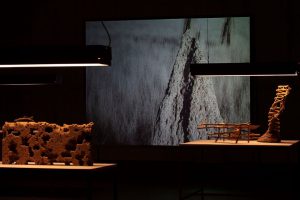Review: Agatha Gothe-Snape, ‘Trying to Find Comfort in an Uncomfortable Chair’ & Nicholas Mangan, ‘Termite Economies (Phase One)’ ·
Perth Institute of Contemporary Arts ·
Review by Claudia Minutillo ·
Object lessons in memory and meaning
5 August 2019
- Reading time • 5 minutesVisual Art
More like this
- A walk with Tina Stefanou
- A blaze of glorious people
- Diving into the gothic world of Erin Coates
Forming a deep and rich understanding of the recent past can be difficult. Our ability for retrospection often improves as we travel a greater temporal distance. The two latest exhibitions from Perth Institute of Contemporary Arts, however, turn this notion on its head.
Spanning PICA’s Ground Floor Galleries, “Trying to find Comfort in an Uncomfortable Chair” is the culmination of a research project into the Cruthers Collection of Women’s Art led by Australian contemporary artist Agatha Gothe-Snape.
A rare gem, the Cruthers Collection of Women’s Art is Australia’s only public women’s art collection. This exhibition signifies its first public return to PICA since 1995 and creatively re-examines some of the collection’s foundational narratives of domesticity, still-life and self-representation.
The show includes artworks from the Cruthers Collection and new works produced by Gothe-Snape in response, giving the collection breathing room as if it were a living, conscious being. Cruthers Collection curator Gemma Weston, who collaborated with Gothe-Snape on this project, aptly describes the exhibition as “a dream the Cruthers Collection of Women’s Art itself might have, if it were able to”.
In this dream-like mode, a viewer can (and should) navigate the space intuitively, first entering through Gothe-Snape’s installation Certain Situations/ EXPRESSION CURTAIN (2013). Previously acquired by the Cruthers Collection, the work is comprised of a large makeshift wall with a cut-out doorway in which a patterned yellow curtain hangs. Among other things, the installation draws attention to the performative nature of engaging with art objects in the show.
Some artists featured from the Cruthers Collection include Elise Blumann, Penny Bovell, Susanna Castleden, Penny Coss, Rosalie Gascoigne, Eveline Kotai, Ann Newmarch, Miriam Stannage and Mei Swan Lim. Their work spans across painting, textiles, print, drawing, sound and media. Within this myriad of expression, layers upon layers of meaning accrue which regrettably cannot be expressed in full here. However, the central feature which must be mentioned is the work from which the exhibition takes its title, and one of Gothe-Snape’s new responsive works.
In the centre of the space, a large platform displays a number of chairs loaned from exhibiting artists – the chair chosen had to be one in which the artist has found comfort. Some torn and frayed, some splattered with paint or just a skeleton of what once was, the borrowed chairs so beautifully manifest the artist’s presence through the object alone. Accompanied by Gothe-Snape’s letters to the artists requesting the chairs, we are invited to see the objects as a symptom of all their experiences. Through this, we immerse ourselves in one large connective web of shared feeling, experience and memory across time and space.
Upstairs, Nicholas Mangan’s “Termite Economies (Phase One)” brings the viewer back down to earth with a less whimsical aesthetic of insects and brown dirt. Mangan’s work is also the culmination of a research project. In this case, the Australian science agency CSIRO investigated termite behaviour in the hope their industrious methods might assist humans in their pursuit of gold.

Occupying a much smaller and contained space, nightmarish rather than dream-like, the dimly lit room accentuates the stark artificiality of the bay lights which illuminate Mangan’s earthy termite sculptures from above. The organic forms have been rendered by a 3D printing process and are cross-sectioned to reveal inner passages; human innovation and research meets animal instinct.
These sculptures provide an access point to thinking about recent capitalist pursuit, economic viability and its reflection on society’s behavior and motivation. We may well imagine ourselves as these little termite colonies and speculate on possible futures. Accompanying the sculptures, retro monitors play archival and recorded footage of termite activity, showing the termites at work and also at a cellular level. The juxtaposition of historical and contemporary objects and visuals position the ideas explored as trans-historical, looking at the past in less rigid and more speculative, all-encompassing ways.
Perhaps the resounding point over all is that a focus on the embodied experience of objects and the contested ideas they encompass may provide a deeper understanding the recent past and present moment. These two exhibitions are not to be rushed through and are made all the more meaningful if the viewer is committed to their own participation, thinking and research into the objects before them.
Pictured above: Agatha Gothe-Snape’s installation ‘Trying To Find Comfort in an Uncomfortable Chair’ in the PICA main gallery. Photo by Bo Wong.
Like what you're reading? Support Seesaw.





